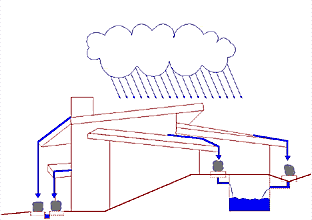
| Home |
| Introduction |
| |
| |
| Hypothesis |
| Methodology |
| Data & Analysis |
| Conclusion |
| Credits |
| Learn More |
 Front view |
 Back view |
 Rooftop view (photo by Eimar Boesjes) |
Introduction
Anita Van Asperdt and Eimar Boesjes treat rainwater as a valuable resource rather than a problem. The metal roofs of their newly constructed house are designed to collect and direct rainwater into an 8,000-gallon underground cistern where it is stored for later use. According to rooftop collection potentials, the typically wet winters of Oregon will provide them with enough water to irrigate their landscape and perhaps reduce their dependence upon municipal water utilities for indoor use.
Located in the south hills of Eugene, Oregon, the house is perched on a steep slope surrounded by Douglas fir woodlands. Rainwater from two of the four roof planes is harvested and stored in a concrete cistern while collection from the other roofs is diverted through a backyard streambed and ultimately into the abutting wetlands.
 Fig. 1: Rainwater collection system |
 Fig. 2: Filter placement detail |
The rainwater catchment system consists of painted steel roof structures (potable-safe coating). The water is artfully channeled from the rooftop to truncated downspouts that spill onto granite boulders at ground level. (see fig. 1) These boulders sit atop concrete footings that house pipes leading to the cistern inlets.
At present, the system is devoid of any filtration system to help purify stored water. The owners intend to add sand filters (fig. 2) and perhaps eventually supplement their system with additional means of filtration and/or sterilization in order to raise the water quality to potable standards.
After our initial tour of the home, we generated numerous questions for investigation. The discussions that ensued eventually led to the formulation of a hypothesis.
Rainwater Harvesting is a Vital Signs Case Study
prepared by Angela Matt and
Joshua Cohen, Spring 2001.